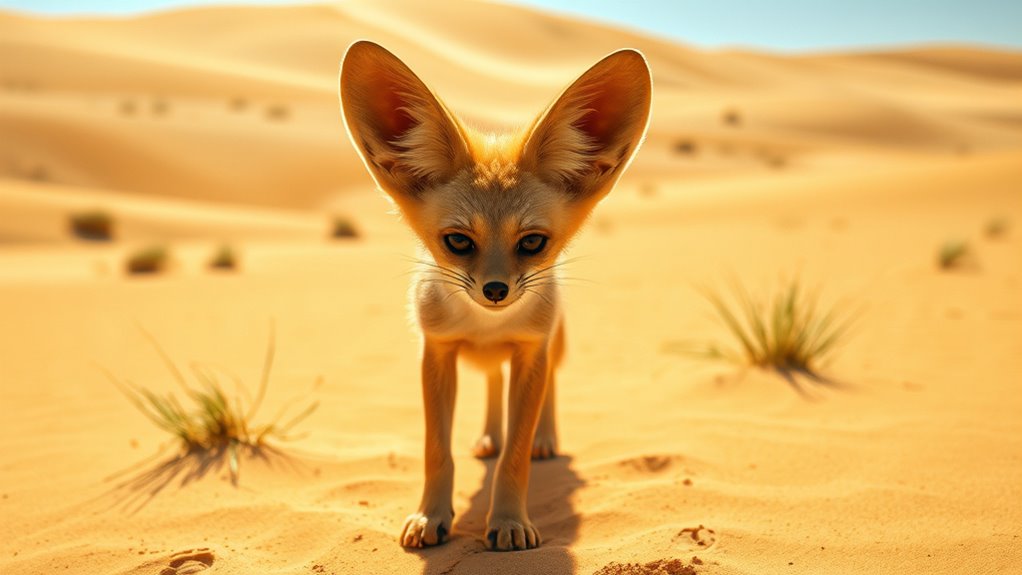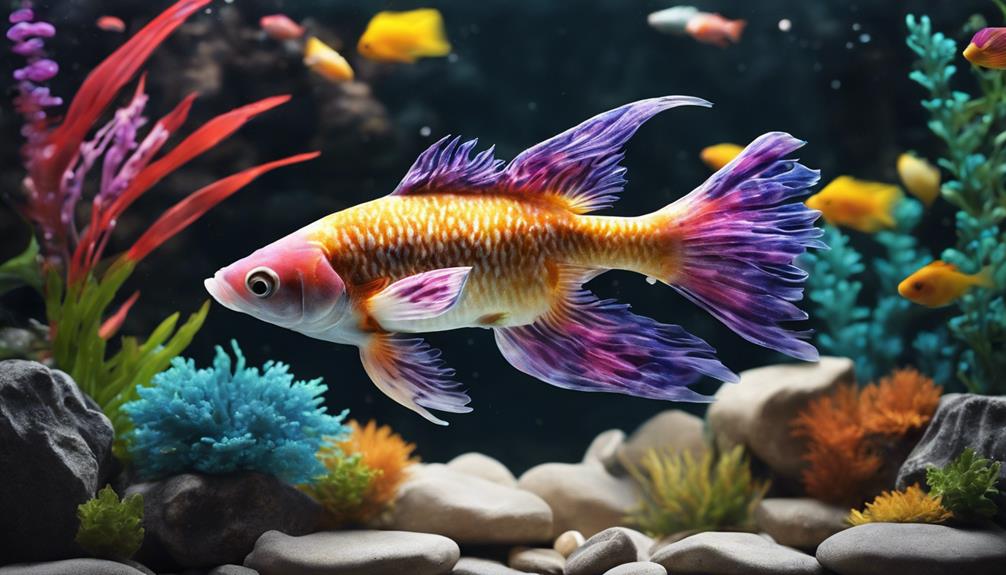Animals adapt to desert life through unique survival strategies. They conserve water by extracting moisture from seeds or forming protective cocoons. Temperature regulation is essential; you might see a fennec fox cooling off with large ears or the Arabian oryx using reflective fur. Many creatures are nocturnal, staying hidden from the sun during the day. Their diets are diverse, often relying on hydration from prey. Explore the fascinating examples of these adaptations and their benefits in the desert.
Key Takeaways
- Animals like kangaroo rats extract moisture from seeds, allowing them to survive without drinking water for long periods.
- Nocturnal behaviors, such as those of the fennec fox, help minimize water loss and avoid extreme daytime heat.
- Species like the African bullfrog enter estivation, remaining dormant during dry spells and emerging when conditions improve.
- The Arabian oryx and thorny devil lizard use reflective coats and color-changing abilities to regulate body temperature in harsh climates.
- Reproductive strategies, such as breeding during the rainy season, ensure offspring have access to necessary resources for survival.
Unique Survival Strategies of Desert Animals
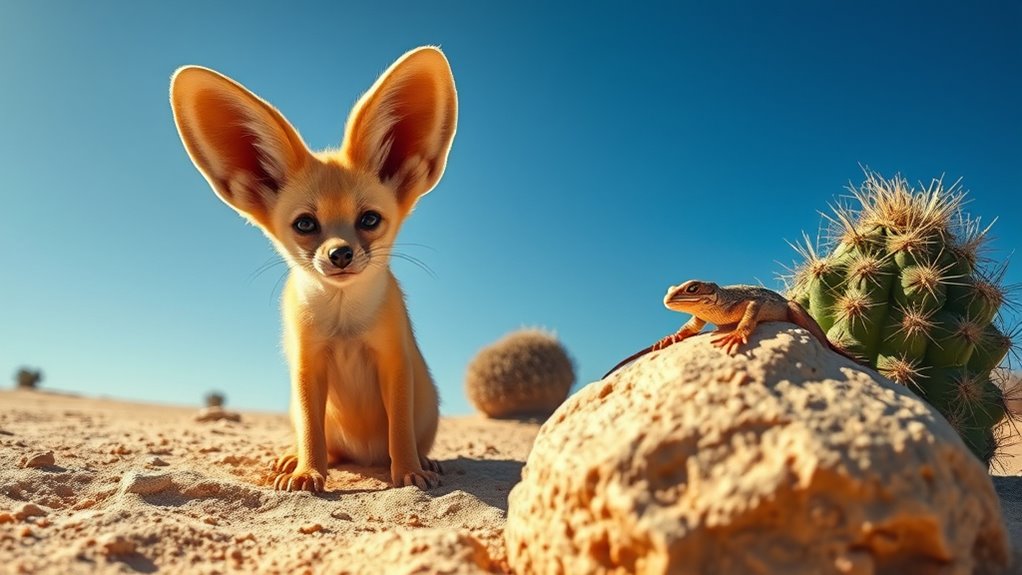
Desert animals have developed remarkable survival strategies that enable them to thrive in extreme conditions. Many, like the kangaroo rat, have adapted to survive without drinking water by extracting moisture from seeds, using specialized kidneys to minimize loss.
The African bullfrog goes a step further, burrowing underground and entering estivation during dry spells, encasing itself in a cocoon of sloughed skin to retain precious moisture.
Meanwhile, the Arabian oryx sports a reflective white coat and can go long periods without water, hydrating from vegetation.
To combat extreme temperatures, nocturnal animals such as the fennec fox hunt at night, while the thorny devil lizard absorbs water through its skin and changes color to regulate body temperature.
Water Conservation Techniques
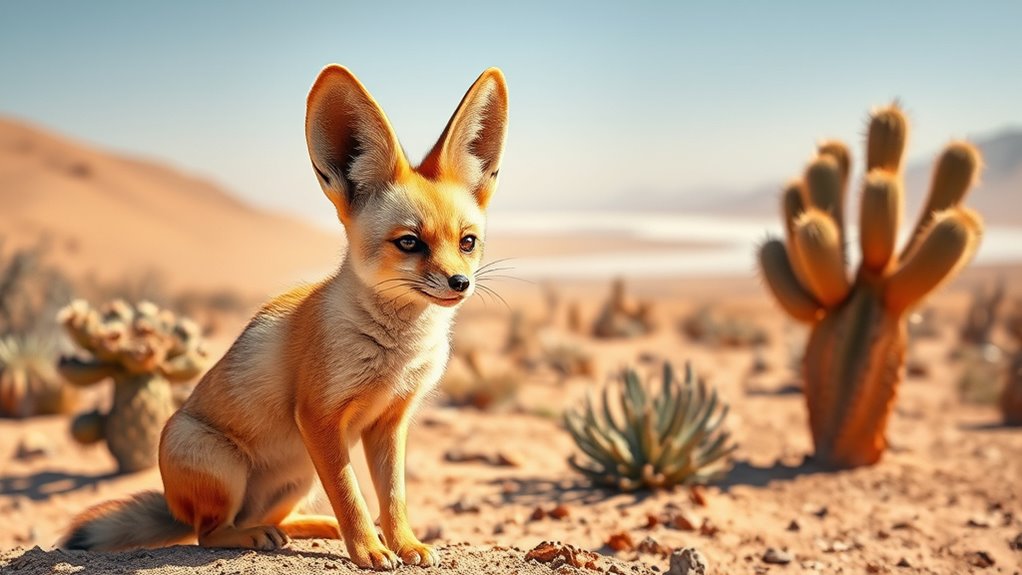
Surviving in harsh desert conditions requires not just unique strategies but also effective water conservation techniques.
Desert animals have evolved remarkable ways to thrive in such arid environments. Here are some key adaptations:
Desert animals showcase incredible adaptations, enabling them to flourish in extreme aridity.
- They obtain moisture from seeds, allowing them to survive without water for extended periods.
- Specialized kidneys help concentrate urine, minimizing water loss while still excreting waste.
- Some species, like the African bullfrog, enter dormancy, forming cocoons from sloughed skin to retain moisture.
- Nocturnal behavior reduces water needs by avoiding the heat of the day and seeking shelter in burrows during the heat.
These techniques enable desert animals to stay hydrated and endure life in one of the planet's harshest climates.
Temperature Regulation Mechanisms
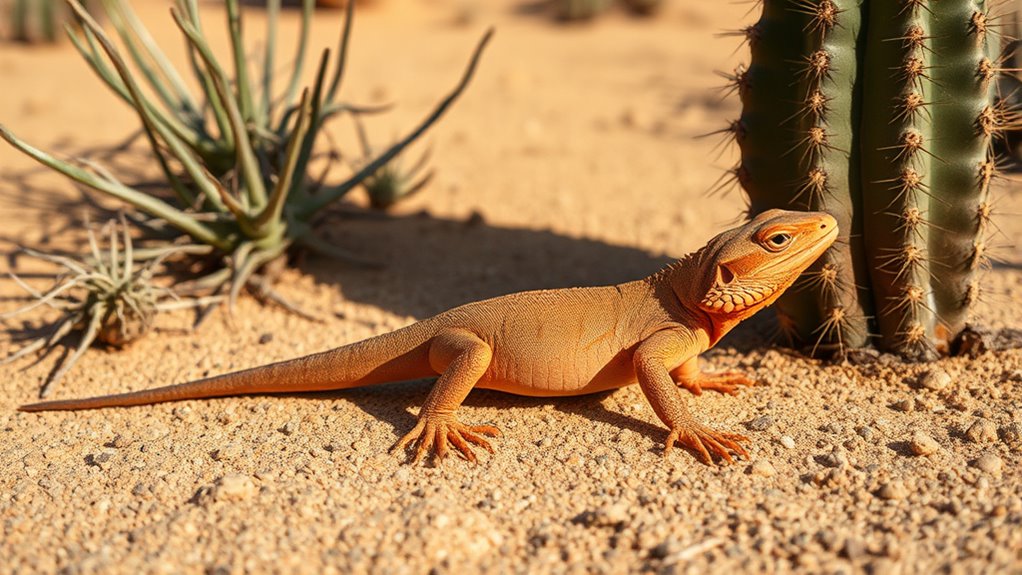
When you think about how desert animals cope with extreme heat, consider their clever temperature regulation strategies.
They use heat-reflective body adaptations, behavioral tactics like seeking shade, and even nocturnal activity patterns to stay cool.
These mechanisms are essential for surviving in such a harsh environment.
Behavioral Thermoregulation Strategies
Inhabiting extreme environments like deserts requires animals to adopt various behavioral thermoregulation strategies to cope with soaring temperatures.
These adaptations help them maintain a stable body temperature and survive the harsh conditions. Here are some key strategies:
- Nocturnal Activity: Many animals, like kangaroo rats, forage at night to avoid extreme heat.
- Seeking Shade: Fennec foxes and white-tailed antelope squirrels find cooler microclimates during the hottest parts of the day.
- Burrowing: Species like the desert tortoise dig into the ground to escape the heat and maintain a stable temperature.
- Panting: Coyotes use panting for evaporative cooling, allowing moisture to evaporate and lower their body temperature.
These behavioral thermoregulation strategies are crucial for survival in desert environments.
Heat-Reflective Body Adaptations
To thrive in the harsh desert climate, many animals have evolved heat-reflective body adaptations that play an essential role in temperature regulation.
For instance, the Arabian Oryx sports a light-colored coat that reflects sunlight, preventing overheating in temperatures soaring to 120°F (50°C).
The fennec fox, with its large ears, dissipates heat efficiently, enhancing its ability to adapt and survive.
Kangaroo rats minimize heat absorption with a low surface area-to-volume ratio, conserving precious water in their bodies.
Additionally, the desert tortoise uses its hard shell to reflect sunlight, keeping its body cooler while resting in burrows.
Finally, the thorny devil cleverly changes skin color to regulate body temperature, darkening to absorb heat or lightening to reflect sunlight.
Nocturnal Activity Patterns
While heat-reflective adaptations help many desert animals cope with extreme temperatures during the day, others have developed nocturnal activity patterns to further enhance their survival.
By being active at night, they can:
- Avoid the intense daytime heat.
- Hunt and forage in cooler temperatures.
- Conserve water and energy by reducing activity.
- Utilize keen senses to find food and evade predators.
Nocturnal species like kangaroo rats and fennec foxes thrive in these conditions.
They've adapted behaviors such as resting in burrows during the day, allowing them to maintain body temperature and minimize exposure to dehydration and heat stress.
These adaptations are vital for their survival in the harsh desert environment.
Behavioral Adaptations for Extreme Conditions

When you think about how desert animals survive, their behavioral adaptations stand out.
Many of these creatures are nocturnal, staying active at night to escape the sweltering heat of the day. They also seek shelter in burrows or under vegetation, allowing them to conserve energy and moisture during the harshest conditions.
Nocturnal Activity Patterns
Many desert animals have adapted to extreme conditions by becoming nocturnal, allowing them to dodge the scorching daytime heat and conserve water.
These nocturnal activity patterns come with specialized adaptations that help them thrive. Here are some key behaviors:
- Enhanced night vision aids in spotting prey and maneuvering in darkness.
- Acute hearing allows for detecting movement and sounds in low light.
- Some, like the African bullfrog, estivate during dry seasons and emerge at night for feeding and breeding.
- Merriam's kangaroo rats venture out for less than an hour each night to minimize exposure to harsh conditions.
Microclimate Shelter Seeking
To escape the brutal heat of the desert, animals often seek out microclimates that provide much-needed relief. These shaded areas help regulate their body temperature and offer a cooler environment for rest and breeding. For instance, cactus wrens hide beneath jojoba plants, while prairie falcons nest on cool, north-facing cliff ledges. White-throated wood rats build insulated dens, and kangaroo rats dig burrows that moderate temperature extremes.
| Animal | Microclimate Type |
|---|---|
| Cactus Wren | Shade from Jojoba |
| Prairie Falcon | North-facing Cliff Ledge |
| White-throated Wood Rat | Insulated Dens |
| Kangaroo Rat | Burrows |
| Kit Fox | Year-round Burrows |
In this way, these adaptations are essential for survival in extreme conditions.
Burrowing Behavior Strategies
Burrowing behavior strategies play an essential role in how desert animals adapt to extreme conditions. By digging burrows, these animals create a refuge that helps them cope with harsh environments.
Here are some key benefits of burrowing:
- Temperature Regulation: Burrows maintain stable temperatures, allowing animals, like the white-throated wood rat, to escape temperature fluctuations.
- Moisture Conservation: They provide a cooler microclimate, helping species like kangaroo rats conserve precious moisture.
- Protection from Predators: Burrows offer shelter from predators and sandstorms, ensuring survival for animals like the fennec fox.
- Estivation: Some, like spadefoot toads, enter estivation within burrows during dry spells, considerably lowering their metabolic rates and conserving energy.
This adaptability is vital for thriving in arid regions.
Dietary Habits of Desert Creatures

Desert creatures have developed unique dietary habits that enable them to thrive in harsh environments. Many herbivores, like the Arabian Oryx, eat drought-resistant plants, obtaining moisture directly from their foliage, which helps meet their water needs without frequent drinking.
Carnivorous desert dwellers, such as the fennec fox and Gila monster, hunt small mammals, insects, and bird eggs to gain hydration and essential nutrients.
Omnivorous species like the desert hedgehog adapt their diets based on seasonal resources, consuming insects, fruits, and small animals.
Additionally, kangaroo rats extract moisture from seeds, relying on metabolic water during digestion.
Some rodents, including the Sonoran pronghorn, can digest dry grasses and cactuses, maximizing nutrient absorption from what others avoid.
Reproductive Strategies in Arid Environments
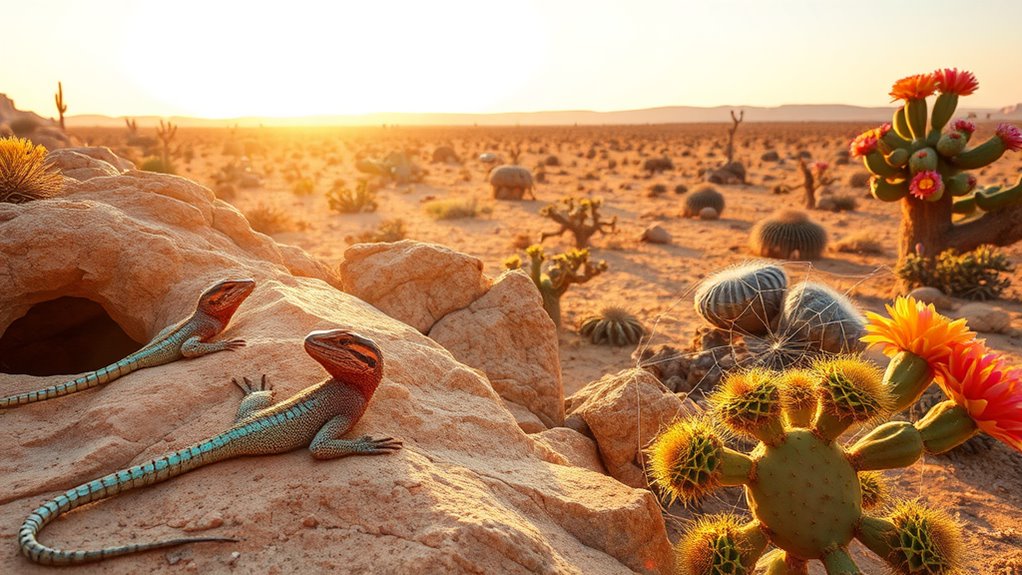
As harsh conditions persist in arid environments, many desert animals have evolved remarkable reproductive strategies to secure their survival.
These strategies help guarantee that their offspring thrive despite limited resources. Key adaptations include:
Desert animals employ unique strategies to ensure their offspring survive in resource-scarce environments.
- Timing Breeding: Many species, like the Couch's Spadefoot Toad, breed during the rainy season, maximizing water source availability.
- Estivation: Animals such as the African Bullfrog undergo estivation, remaining dormant until conditions improve enough to breed.
- Egg Protection: The Desert Tortoise lays eggs in burrows, shielding them from desiccation and enhancing survival chances.
- Rapid Offspring Maturation: Species like kangaroo rats quickly mature their young to take advantage of favorable environmental conditions.
These strategies illustrate how desert animals adapt to secure their lineage continues in harsh climates.
Notable Examples of Desert Adaptations

Many desert animals have developed fascinating adaptations that enable them to thrive in extreme conditions. These adaptations help them survive the heat of the day and the lack of water. Here are some notable examples:
| Animal | Adaptation | Benefit |
|---|---|---|
| Kangaroo Rat | Obtains moisture from seeds | Survives without drinking water |
| Arabian Oryx | White coat reflects sunlight | Tolerates high temperatures |
| Fennec Fox | Large ears dissipate heat; nocturnal behavior | Avoids extreme daytime temperatures |
| Gila Monster | Stores fat in tail; active at night | Conserves energy during food scarcity |
These remarkable adaptations illustrate how animals have truly adapted to the desert, ensuring their survival in harsh environments.
Frequently Asked Questions
How Do Animals Adapt to the Desert?
When you think about how animals adapt to the desert, consider their unique strategies for survival.
Many species become nocturnal, staying active during cooler nights to avoid daytime heat. Others develop specialized kidneys to conserve water or large ears to dissipate heat.
You might notice some animals burrowing underground to escape harsh temperatures, while others find moisture in the plants they eat.
These adaptations help them thrive in such extreme environments.
How Animals in the Desert Have Adopted a Lifestyle to Survive the Heat?
Desert animals have developed unique lifestyles to cope with extreme heat. You might notice that many are nocturnal, becoming active at night to avoid the scorching sun.
Some dig burrows, creating cool, insulated spaces to escape the heat. Others have adapted their diets, eating moisture-rich plants.
You'll find that many species have efficient kidneys to conserve water, while others seek shade or microclimates to stay cool and manage their body temperature effectively.
What Are 5 Examples of Animal Adaptations in Animals?
When you think about animal adaptations, consider these five striking examples:
Camels have thick fur for insulation and large feet for stability.
Kangaroo rats concentrate urine to survive without water.
Fennec foxes utilize large ears to dissipate heat and live nocturnally.
Horned lizards capture dew for hydration and squirt blood for defense.
Desert tortoises conserve moisture through burrowing and thrive on a diet of cacti.
Each adaptation showcases nature's ingenuity in survival.
How Do Animals Adapt to a Hot Environment?
Animals adapt to hot environments in various ways.
You'll notice some become nocturnal, staying active at night when temperatures drop. Others develop physical traits, like large ears for heat dissipation or thick fur to reflect sunlight.
Many burrow underground, creating cool shelters away from the heat. Some can even absorb moisture through their skin or store fat, allowing them to survive long periods without food and water.
These adaptations help them thrive in harsh conditions.
Conclusion
To sum up, the remarkable adaptations of desert animals showcase nature's ingenuity in overcoming harsh conditions. While some might argue that these adaptations are merely survival tactics, they're also proof of the resilience of life. Each strategy, from water conservation to unique reproductive methods, highlights a complex interplay of evolution and environment. By understanding these adaptations, you gain a deeper appreciation for the delicate balance that sustains life in one of the planet's most challenging habitats.
